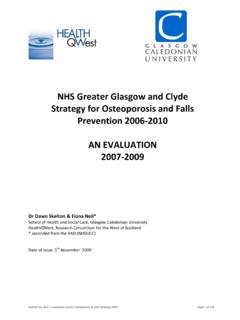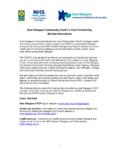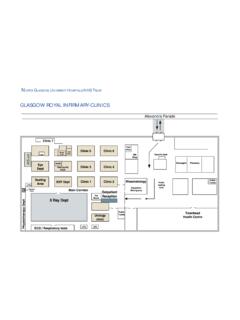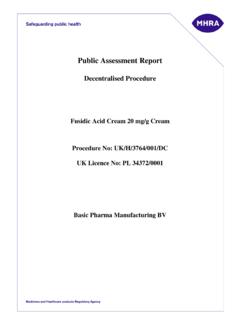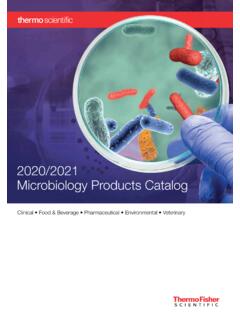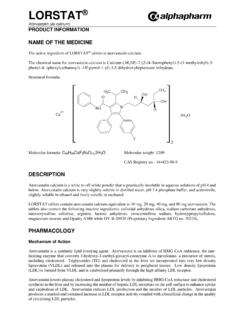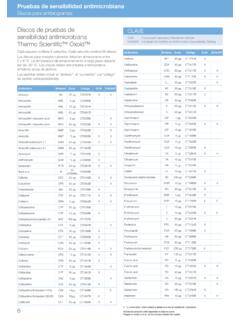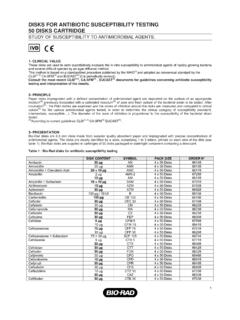Transcription of Infection Control Care Plan for a patient with MRSA - NHSGGC
1 Infection Control care plan for a patient with MRSA Patients Name: Unit No: Hospital/Ward: Page 1 of 4 Infection Control care plan for a patient with MRSA Statement: This care plan should be used with patients who are suspected of or are known to have MRSA. This care plan should be followed to reduce the risk of transmitting MRSA to other patients, staff, carers and visitors. If it is not possible to follow this policy, please notify a member of the Infection Control Team who will carry out a risk assessment on how best to care for this patient . Date No Issue / Problem Action to be taken Ongoing Assessment / Review Date Signature Comment 1 Accommodation Isolate the patient in a single room with en-suite facilities. If en-suite is not available ensure access to own commode. Place an isolation sign on the outside of the door.
2 If there are no single rooms available, contact a member of the Infection Control Team for advice. 2 Hand Hygiene Hand hygiene must be performed before and after contact with the patient , their environment or equipment, and on leaving the isolation room. Soap and water or alcohol gel (if hands are visibly clean) can be used for hand decontamination. Gloves should be used to prevent hand contamination. After glove removal hands must be decontaminated. Ensure hand washing facilities are offered to the patient regularly, especially before eating and after using the toilet. Encourage patients to keep their nails short and clean. 3 Personal Protective Equipment (PPE) Wear plastic aprons and gloves for contact with the patient , the immediate patient environment and equipment. Visitors are NOT required to wear gloves and aprons 4 Specimens ICN will advise.
3 Following first isolate, a full screen is required. Nose and groin, and any other vulnerable site, wound, catheter, central line, if signs of Infection are present etc. See screen chart on page 4. 5 Decontamination of patient Equipment Equipment where possible should be designated for the patients own use and kept in their room. Equipment removed from the room must be cleaned with chlorine based detergent, eg Actichlor Plus. patient crockery/ cutlery should be removed from the room and washed in the normal way. Keep items/ equipment to a minimum within the room. Equipment should be cleaned between and after use. patient Demographic / label Infection Control care plan for a patient with MRSA Patients Name: Unit No: Hospital/Ward: Page 2 of 4 Date No Issue / problem Action to be taken Ongoing Assessment / Review Date Signature Comment 6 Laundry All patient linen should be changed on a daily basis.
4 Place used linen in alginate bag, then clear polythene bag, then into a white laundry bag. Clean linen to be taken into the room only when required. Do not store clean linen in room. Please ensure the patient information leaflet Taking Laundry Home Information for Carers is provided if required. 7 Waste Dispose of all waste into clinical waste pedal bin inside room. When sack full fasten securely and label with ward ID. 8 Environmental cleaning To maintain confidentiality advise domestic staff that the patient is being isolated. Floor, surfaces, sink, toilet etc. must be cleaned twice daily by domestic staff using chlorine based detergent, eg Actichlor Plus. Please refer to SOP Twice Daily Clean of Isolation Rooms. Nursing staff are responsible for the cleaning of patient related equipment twice daily using chlorine based detergent, eg Actichlor Plus.
5 When room vacated nursing staff should clean patient related equipment with chlorine based detergent, eg Actichlor remove it from the room. Domestic staff should then carry out a thorough terminal clean of the room. When dry the room can be used. Please refer to SOP Terminal Clean of Isolation Room. 9 Visitor restrictions Visitors do not have to wear PPE but must ensure they decontaminate their hands before and after leaving the room. Visitors should be discouraged from sitting on the patient s bed. Visitors report to nurse in charge before entering. Visitors are NOT required to wear gloves and aprons, but should wash their hands when leaving the room. Infection Control care plan for a patient with MRSA Patients Name: Unit No: Hospital/Ward: Page 3 of 4 Date No Issue / problem Action to be taken Ongoing Assessment / Review Date Signature Comment 10 Personal clothing There are no special washing instructions.
6 Relatives should wash their hands after handling used linen. Personal laundry contaminated with blood or body fluids should be placed in a patient clothing alginate bag before being given to the carer or relative for home laundering. 11 Transfer to another department or hospital Prior to transfer the receiving area/ department, eg radiology, they must be informed of the patients MRSA status. Ward staff should inform the Infection Control Team of planned transfer to allow risk assessment of the patient and receiving area to ensure the most appropriate patient placement. 12 Treatment / eradication as appropriate Eradication therapy should only be used on positive screen sites, nose only positive, only Mupirocin (Bactroban) nasal ointment should be used.
7 Treatment of Mupirocin resistant strains of MRSA will be advised by the ICT Colonised patients should receive 2 attempts at eradication therapy. If unsuccessful continued therapy should be discussed with the microbiologist. Eradication therapy should be carried out for 5 days, then stopped. patient should be re-screened after 48 hours after all treatment for decolonisation has stopped. See treatment and screen sheet for further advice. See page 4. 13 Isolation of patient Patients can be removed from isolation when 2 full consecutive negative screens have been obtained at intervals of no less than 72 hours, beginning at least 48 hours after antibiotic / decolonisation therapy has been completed. Patients should only be removed from side room after consulting the ICT. Infection Control care plan for a patient with MRSA Patients Name: Unit No: Hospital/Ward: Page 4 of 4 Screening Results Date: Nose Groin ERADICATION REGIMEN FOR MRSA This regimen should be commenced on the advice of the Infection Control Nurse/Doctor.
8 Use this regimen for 5 days then stop. CLINISAN BODYWASH ADVANCE: Use for 5 days (Order a 250ml bottle from pharmacy) Mupirocin (Bactroban) Nasal: Use 3 times a day for 5 days 1. Apply neat to the skin 2. Pay particular attention to the following areas: hairline, around nostrils, under the arms, perineum/groin, feet 3. Clinisan Bodywash Advance should be in contact with skin for at least 30 seconds 4. Wash body with disposable cloth or wipes rinse skin thoroughly 5. After washing provide the patient with a change of clothing/pyjamas and bed linen 6. NOTE: If Clinisan Bodywash Advance causes irritation of the skin discontinue use and contact Infection Control Nurse Apply to anterior nares three times a day as follows: 1. Unscrew the cap and squeeze a small amount (about the size of a matchhead) onto the little finger or a cotton bud. 2. Apply to inside of both nostrils.
9 3. Close the nostril by momentarily pinching the nose together and massaging to spread the ointment Mupirocin should only be used for two five-day courses and should never be used for prolonged courses or used repeatedly. Mupirocin Resistant MRSA Nasal fusidic acid in combination with polymyxin (polyfax) should replace mupirocin. All other instructions / cautions in relation to the use of mupirocin also apply to fusidic acid. Patients should not be removed from isolation / cohort until at least two full consecutive negative screens have been obtained at intervals of no less than 72hrs, beginning at least 48hrs after antibiotic / decolonisation therapy has been completed. Patients should only be removed from side room after consulting the ICT. CLINISAN BODYWASH ADVANCE NASAL BACTROBAN Re-Screen date Date Commenced Date completed Date Commenced Date completed




